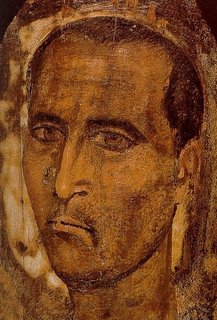KSRK: KierkeGirard; Bellinger on Girard's theory of Mimetic Desire in Kierkegaard's Christian Discourses and The Sickness Unto Death
It's true that I haven't been as diligent as I should be when it comes to finishing up the Stages. It isn't true that I've completely forgotten about it. As usual, I've been turning to other authors to get some kind of handle on Kierkegaard, whose style is often quite simply opaque. One great book I finished last week is by Eugene Webb (from the University of Washington!), called Philosophers of Consciousness: Polanyi, Lonergan, Voegelin, Ricoeur, Girard, Kierkegaard. This has led to a longer dalliance with Rene Girard's theory of mimetic desire, and in particular his analysis of scapegoating in both history and myth. This led to the article linked to above, from which I've excerpted the following introduction. The entire article is well worth reading.
"Mimetic desire is the main starting point for Girard's theory of personality and culture. Human beings have a basic feeling of existential lack which leads them to look to a model who seems to possess a greater fullness of being. The desires of the model are imitated in the hope of acquiring a similar fullness of being. In Girard's words:
Kierkegaard's book Christian Discourses, which receives very little scholarly attention, contains a psychological analysis which clearly anticipates Girard's theory of mimetic desire. In the discourse on "The Worry of Lowliness,"[3] for example, Kierkegaard describes three modes of being, which are represented by the bird, the heathen, and the Christian. The bird, along with the lily, represents for Kierkegaard the realm of nature. Kierkegaard's description of the behavior of the "heathen" is almost identical to Girard's psychology. Consider the following quotation:
"Mimetic desire is the main starting point for Girard's theory of personality and culture. Human beings have a basic feeling of existential lack which leads them to look to a model who seems to possess a greater fullness of being. The desires of the model are imitated in the hope of acquiring a similar fullness of being. In Girard's words:
When modern theorists envisage man as a being who knows what he wants, or who at least possesses an "unconscious" that knows for him, they may simply have failed to perceive the domain in which human uncertainty is most extreme. Once his basic needs are satisfied (indeed, sometimes even before), man is subject to intense desires, though he may not know precisely for what. The reason is that he desires being, something he himself lacks and which some other person seems to possess. The subject thus looks to that other person to inform him of what he should desire in order to acquire that being. If the model, who is apparently already endowed with superior being, desires some object, that object must surely be capable of conferring an even greater plenitude of being. (1977, 145-46)Is mimetic desire a phenomenon which is noticed by Kierkegaard?
Kierkegaard's book Christian Discourses, which receives very little scholarly attention, contains a psychological analysis which clearly anticipates Girard's theory of mimetic desire. In the discourse on "The Worry of Lowliness,"[3] for example, Kierkegaard describes three modes of being, which are represented by the bird, the heathen, and the Christian. The bird, along with the lily, represents for Kierkegaard the realm of nature. Kierkegaard's description of the behavior of the "heathen" is almost identical to Girard's psychology. Consider the following quotation:
For it seems indeed as if, in order to be himself, a man must first be expertly informed about what the others are, and thereby learn to know what he himself is--in order then to be that. However, if he walks into the snare of this optical illusion, he never reaches the point of being himself. (1971, 42)Here Kierkegaard is debunking, like Girard, the idea that the desires of the "modern" person are spontaneous and unmediated by society. "Being," in the sense of a centered and coherent self-consciousness, is precisely what the individual lacks; therefore he looks around at the others so that he may pattern himself after them. Kierkegaard and Girard are both describing the double bind in which the individual places himself as he seeks to become himself by copying others. The next passage expands on this theme by opening up the theological dimension of human existence:
For from "the others," naturally, one properly only learns to know what the others are--it is in this way the world would beguile a man from being himself. "The others," in turn do not know at all what they themselves are, but only what the others are. There is only One who knows what He Himself is, that is God; and He knows also what every man in himself is, for it is precisely by being before God that every man is. The man who is not before God is not himself, for this a man can be only by being before Him who is in and for Himself. If one is oneself by being in Him who is in and for Himself, one can be in others or before others, but one cannot by being merely before others be oneself. (1971, 43)This quotation highlights the emptiness and vanity of the "world." When human beings are looking to each other as models of being, the pathway of life is a treadmill or squirrel cage rather than an actual road. The thread is being pulled through the fabric without having been tied at the end. The only context in which human life gains coherence, stability, and purpose is found in the transcendent relationship between the individual and God the Creator. This theme is very clear in Kierkegaard, and I would suggest that it is implicit throughout Girard's writings, whenever it is not explicitly stated."


0 Comments:
Post a Comment
<< Home